Green walnut jam isn't a jam in the typical sense most people will recognize. A preserve of whole, unripe walnuts in syrup, it's one of the most interesting things I've made with the unripe black walnuts to date.
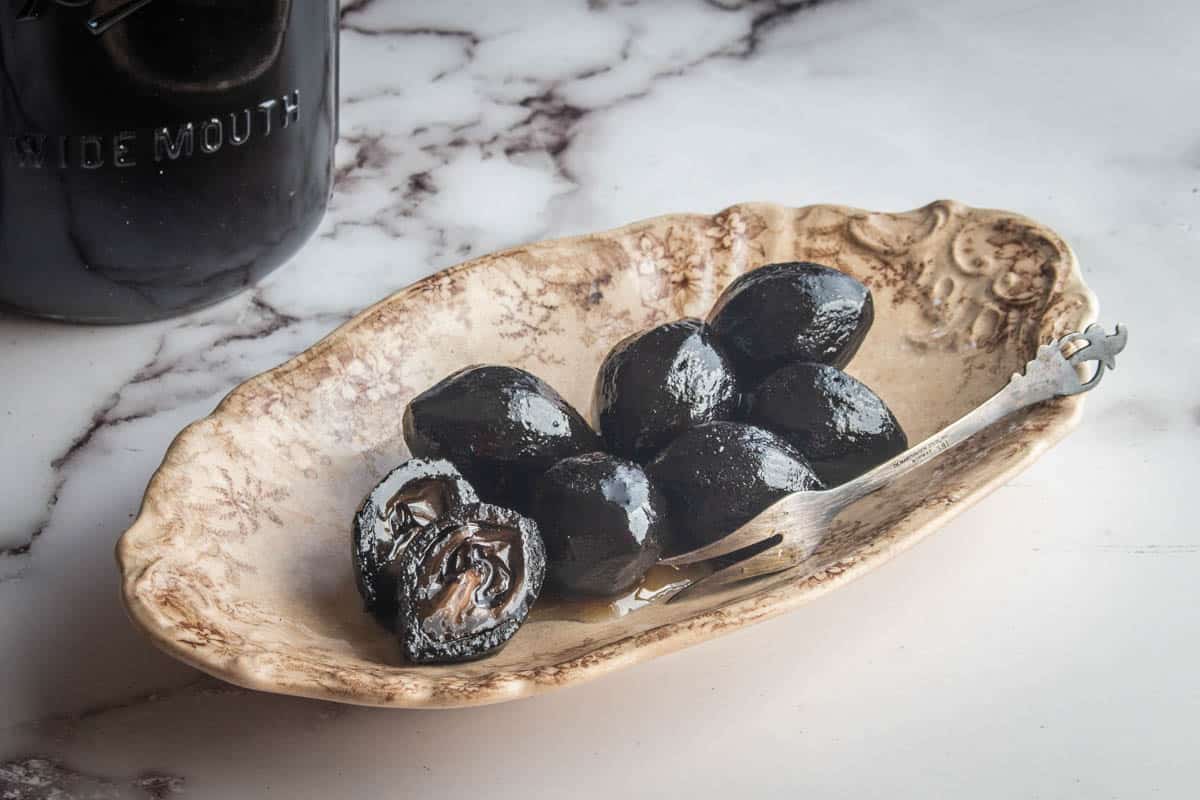
Unlike other recipes that use green walnuts, like nocino, ketchup, or vin de noix, walnut jam allows you to eat the entire unripe nut, husk and all. It's a very special preserve that takes time, but is well worth the work and effort.
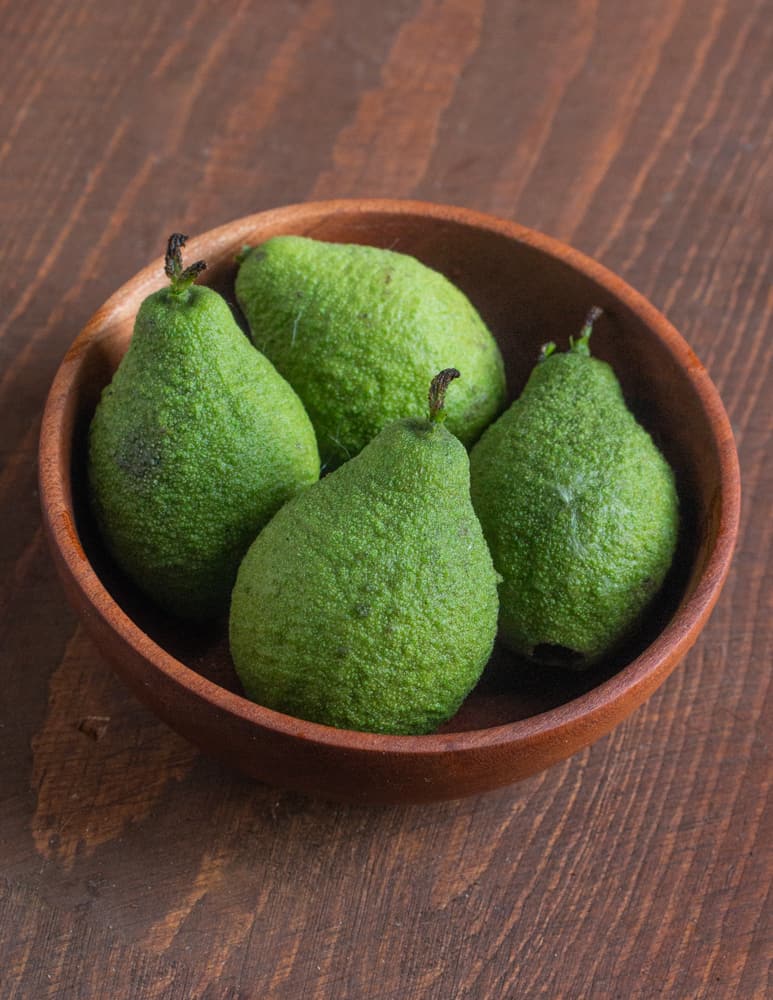
A Traditional Preserve in Syrup
Walnut jam is well-known around the Mediterranean, and I've seen references to it in Greek, Armenian, and Georgian cuisine. In those places, "jam" can be many things. The fruit used could could be everything from apricots, to plums, to, unripe walnuts.
At least with Greek cooking, where they're known as Karitho Glikko, the glikko portion of the name refers to something preserved in syrup. In the Caucuses and Russia the cooking method is known as varenye. In Cyprus it's called Karidaki Glyko.
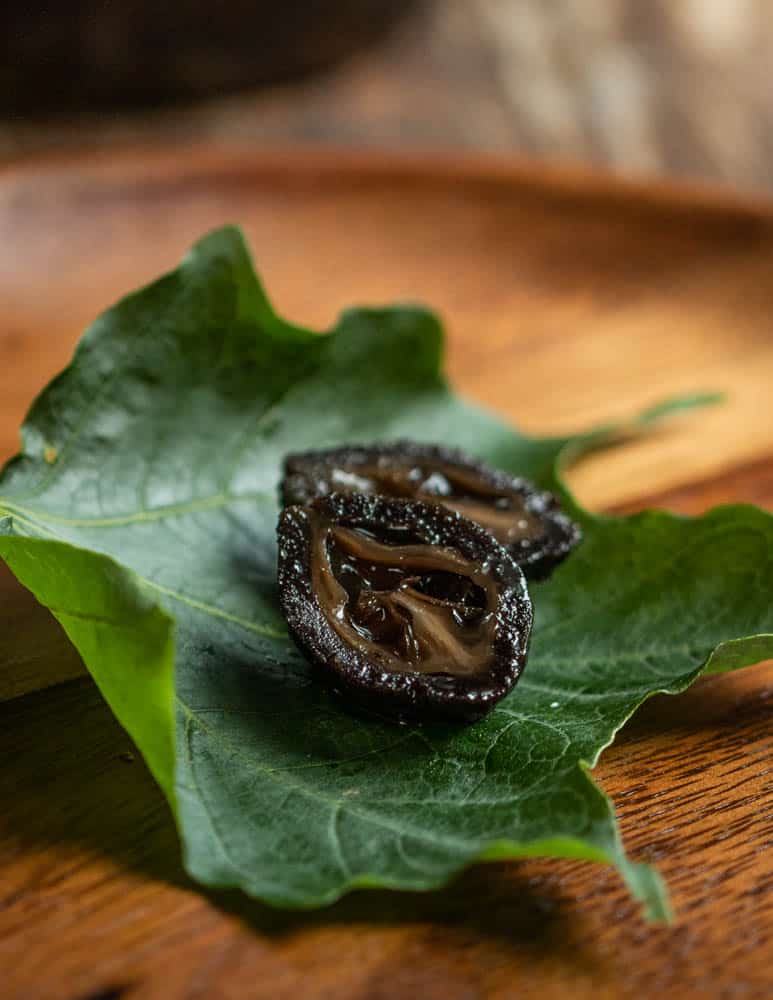
How to Make Black Walnut Jam
There's some variation in recipes I've looked at, but all of them call for peeling and piercing the nuts, as well as soaking in water for a while to calm their tannins (not necessarily in that order).
After making these for a number of years now, I can definitely tell you with certainty that for your walnut jam to taste good, you need to peel, pierce, and soak them in water for at least a week. If you don't the nuts will be bitter and tannic tasting, instead of sweet and mild.
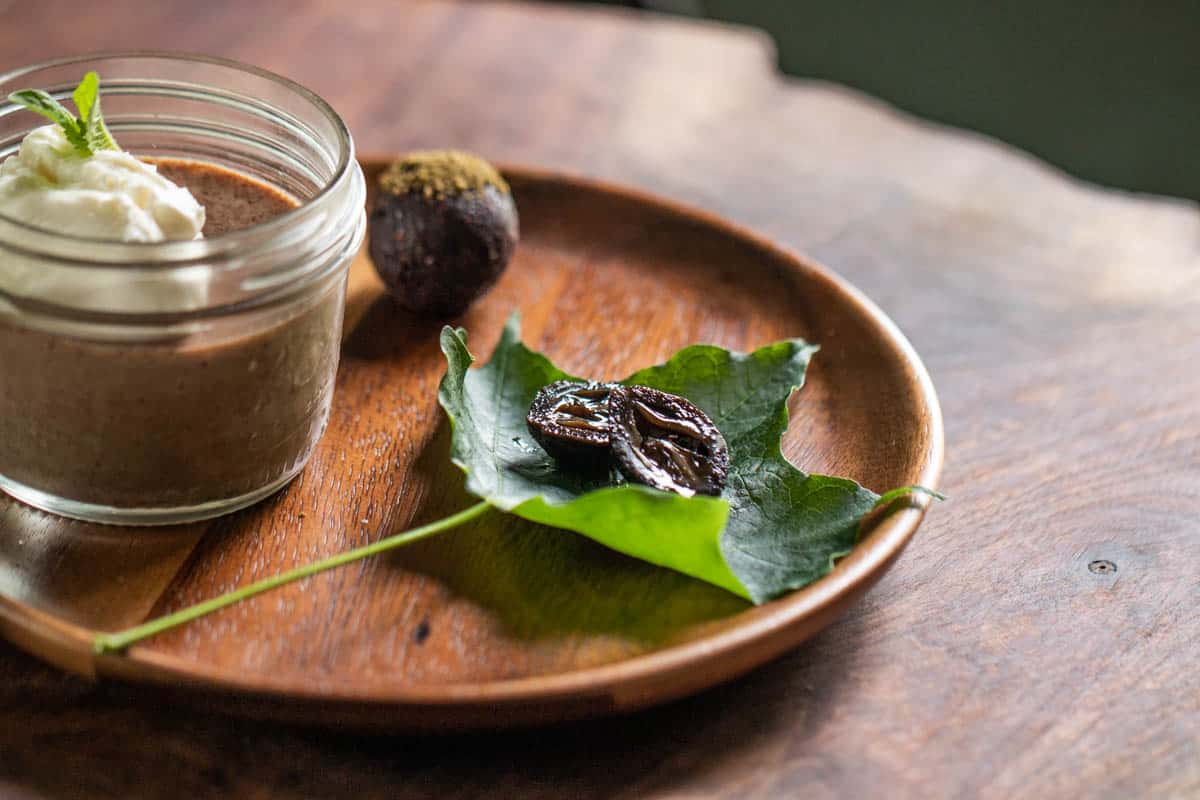
When to harvest the green walnuts
The age of the nuts is by far the most important. You're looking for green walnuts the size of small ping pong balls. If the nuts are too old they will have started to form a shell inside and will be inedible.
If they're too young, they'll be impossible to peel, and won't have as much of the developing nut on the inside, which gets soft and tender after cooking, and is arguably the best part of the preserve. I harvest my green black walnuts around late May through mid-June. See below for images of what I mean here.
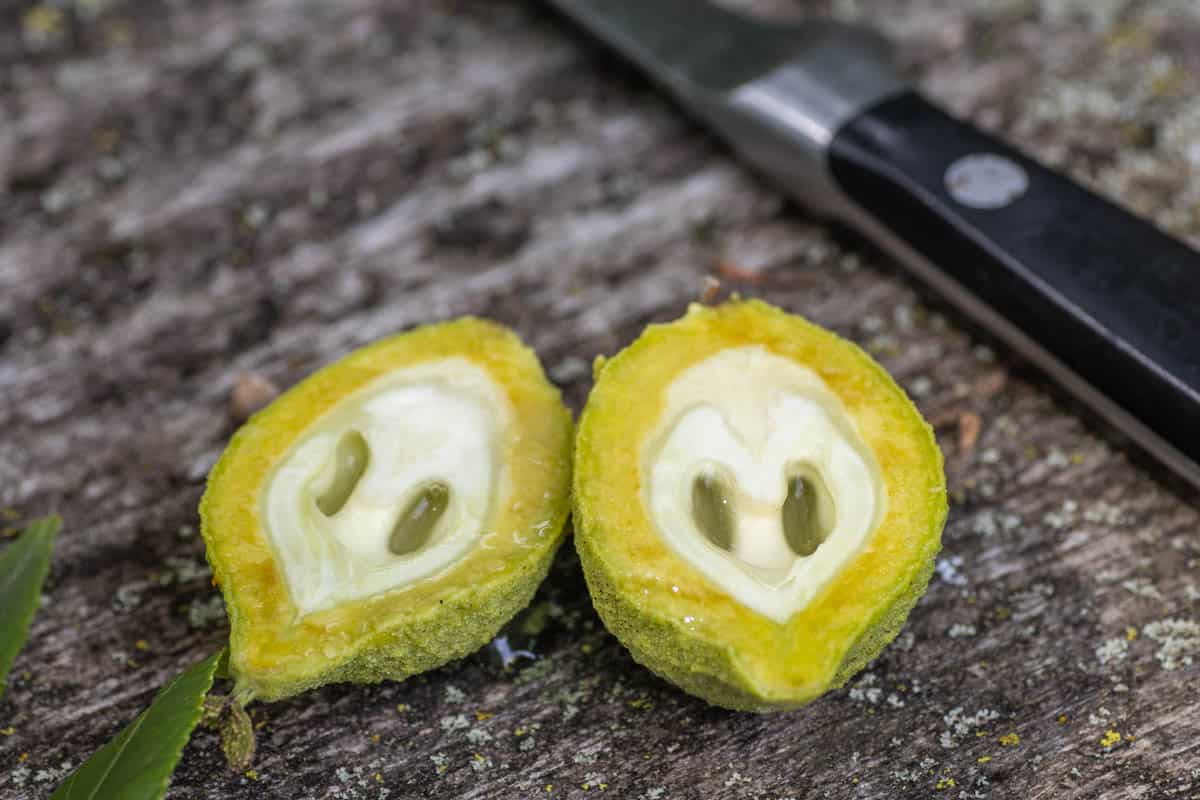
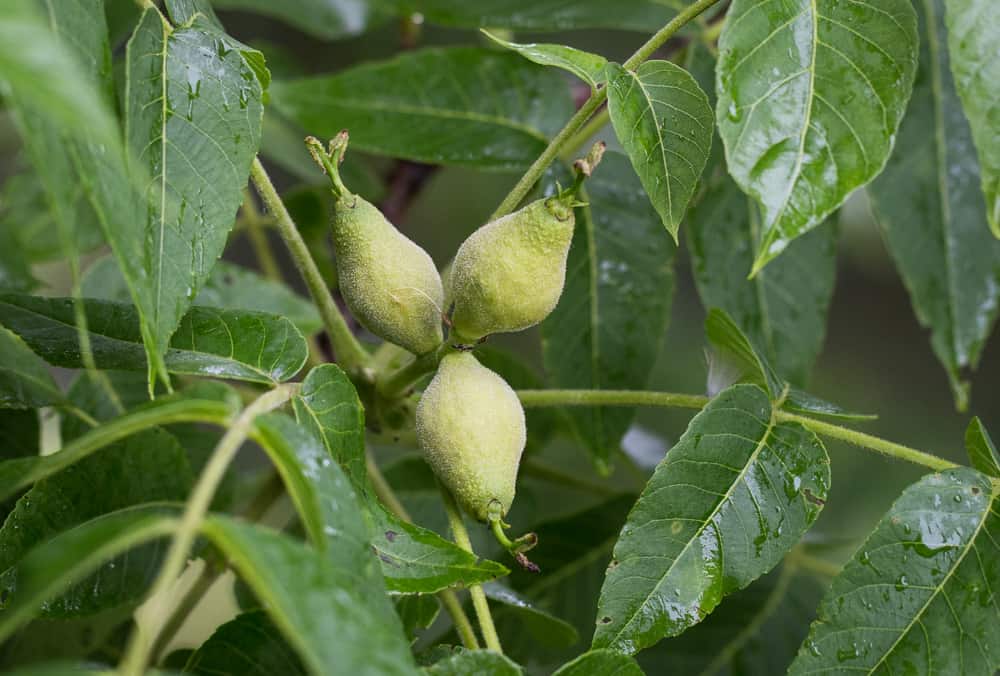
Peeling
Peeling is the most difficult part, and it will take some time. Most of the older recipes call for "paring" the green walnuts, meaning you cut off strips of the green husk with a knife, but for most people that will be too difficult to be practical.
The best way to peel the nuts I've found is with a Kuhn Rikon peeler. Other peelers may work ok, but the Kuhns are the best, and least irritating. They're cheap too, so I recommend getting a few of them.
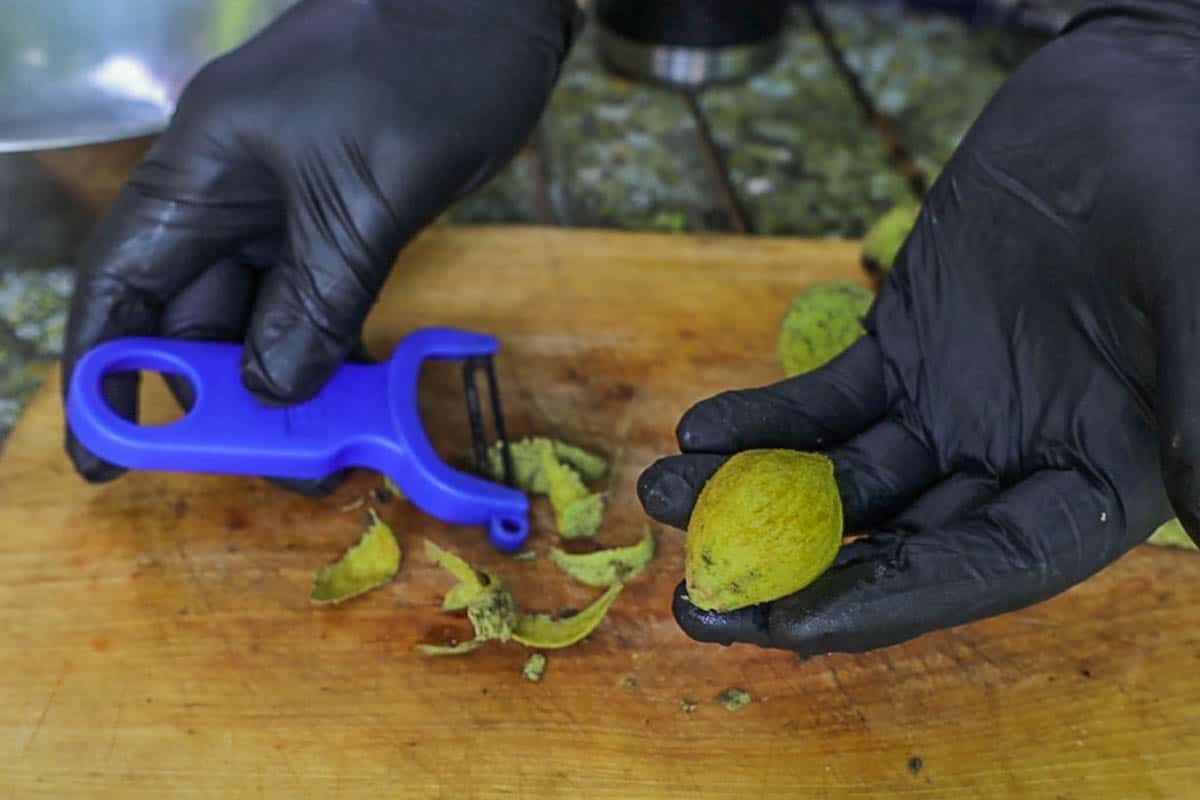
Piercing
The nuts should be pierced before soaking. It may not seem like a big deal, but the small holes from a paperclip, a large needle, or a thermometer as I use in the video here are important. Holes make it so that water can get into the nuts while they soak, increasing the surface area the water can touch, thereby helping to remove tannins.
The most important part of peeling is that it helps the thick sugar syrup penetrate the nuts during the final cooking and help candy the husk, which is unpleasant to eat if not done properly.
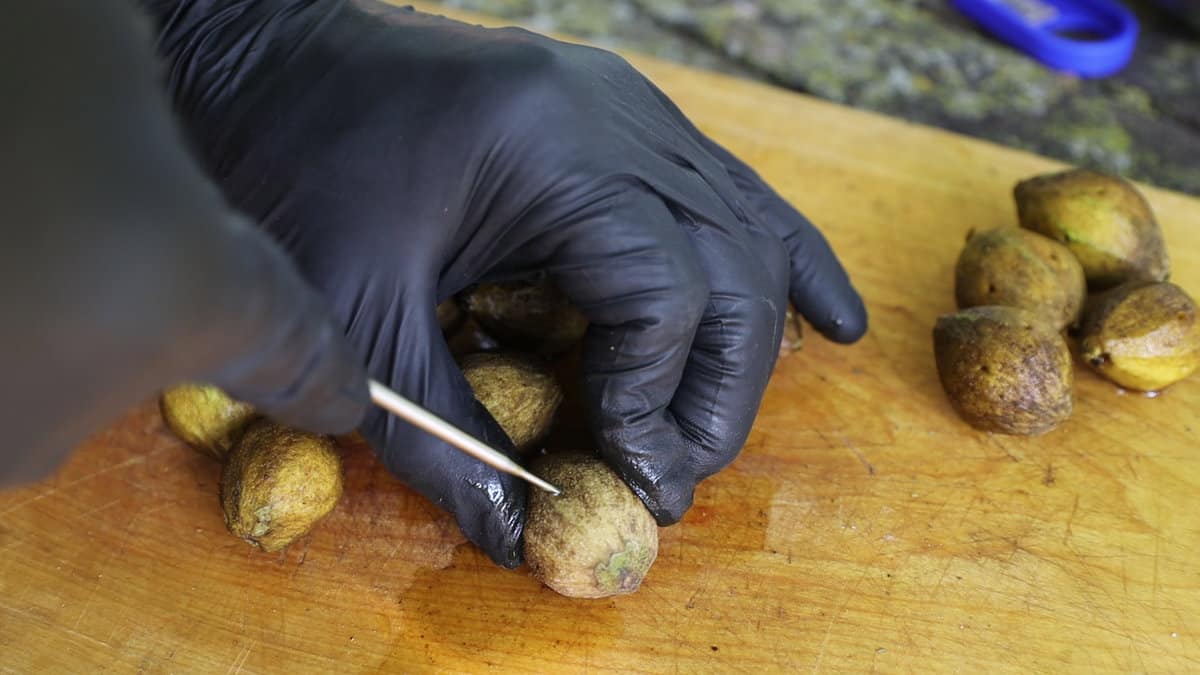
Soaking
Soaking the nuts is the last step in the process and one of the most important. I leave my peeled, pierced green walnuts in water at room temperature for at least a week, but you could probably leave them for longer, especially if you can keep the nuts refrigerated.
Some recipes call for changing the water every few days and you can do that, but if you forget it's ok-I've tried it both ways. The length of time seems to be more important for calming the flavor of the nuts than changing the water regularly.
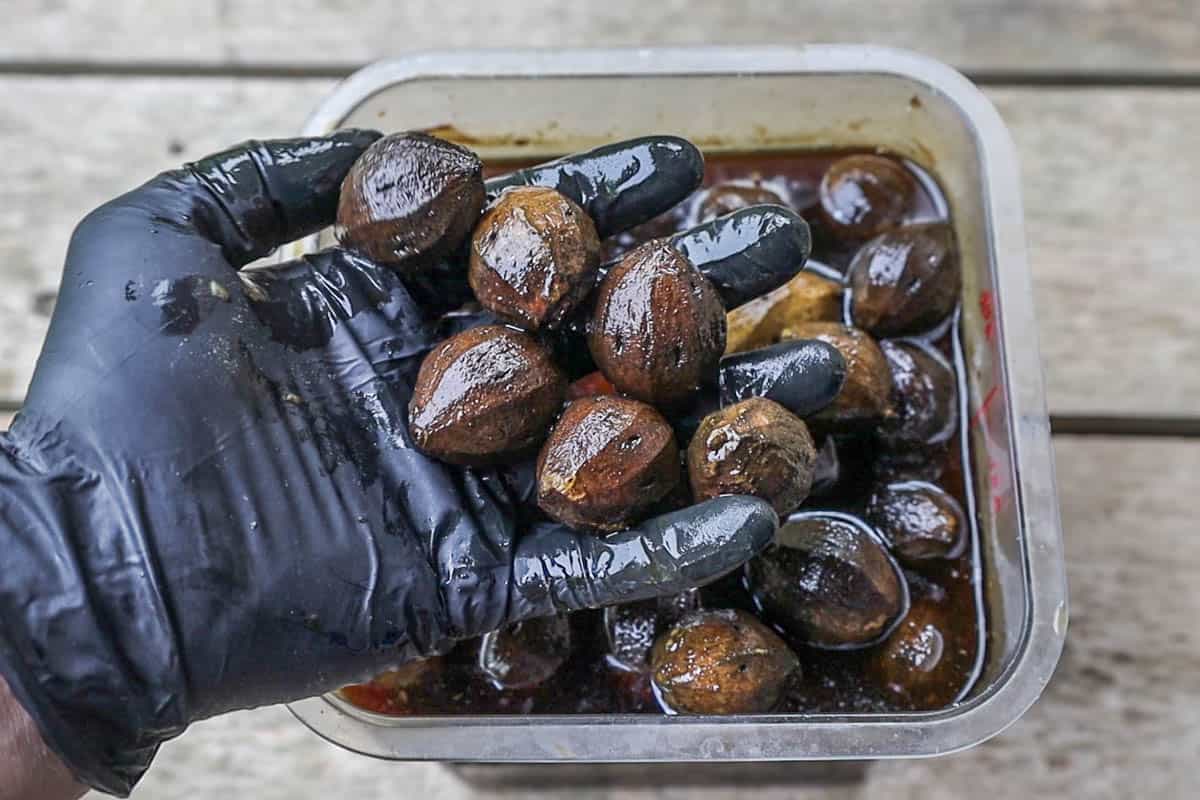
Fermentation
As the nuts soak, depending on the ambient temperature, you'll probably see some bubbles. This is totally fine, and natural, as black walnuts easily ferment on their own without salt.
If you see mold, which is unlikely, don't worry. The final stage of simmering in sugar syrup will kill anything you wouldn't want to eat. The finished product is a fermented preserve jarred in heavy syrup with the addition of acid (lemon juice), making it a very safe recipe.
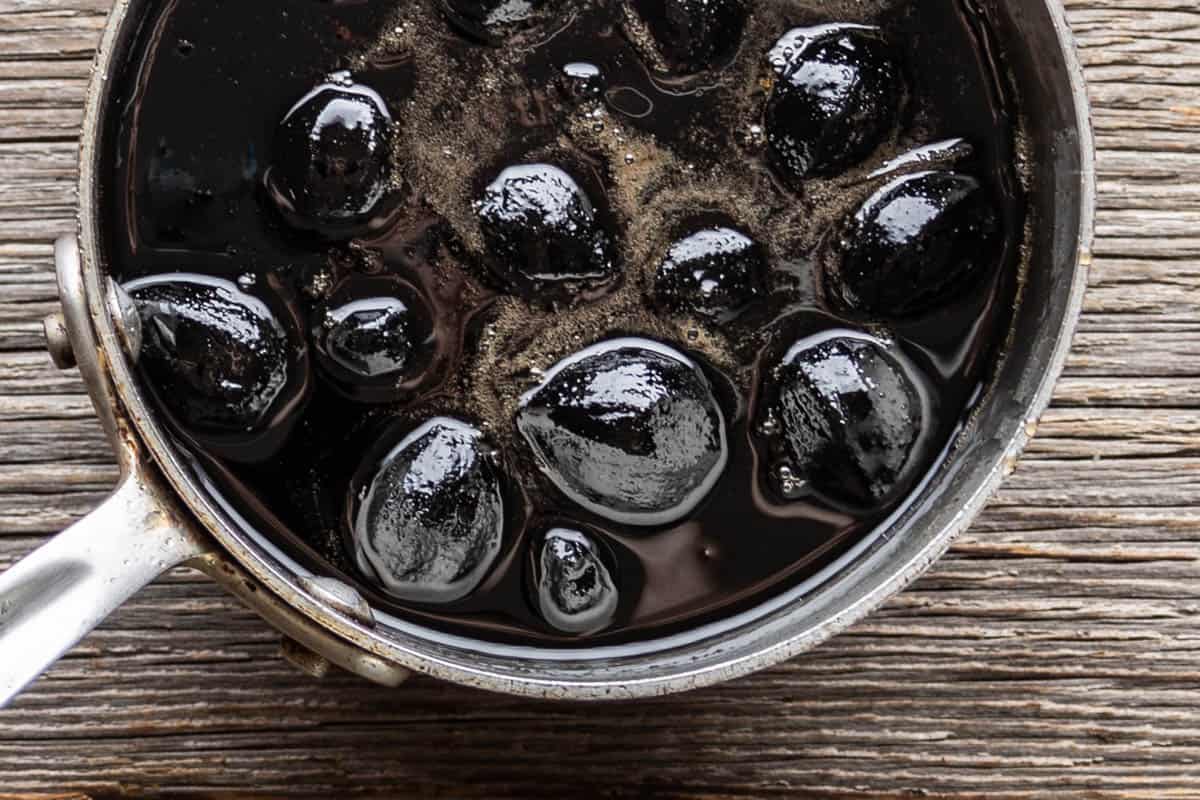
How to Use Walnut Jam
These are a rich, sweet preserve. While a bowl of them looks nice and makes for a great conversation piece, I don't typically sit down and eat more than one of two whole nuts. For the biggest impact, I like to serve the nuts as part of a mignardise tray-a plate of sweets served after dinner.
My mignardises are usually small things like fruit truffles, candied angelica, pates de fruits, amaretti, macarons, etc. If you want to serve them in their purest form, pass around a bowl of nuts cut in half to reveal their shape, along with a small glass of sherry, grappa, marc, etc.
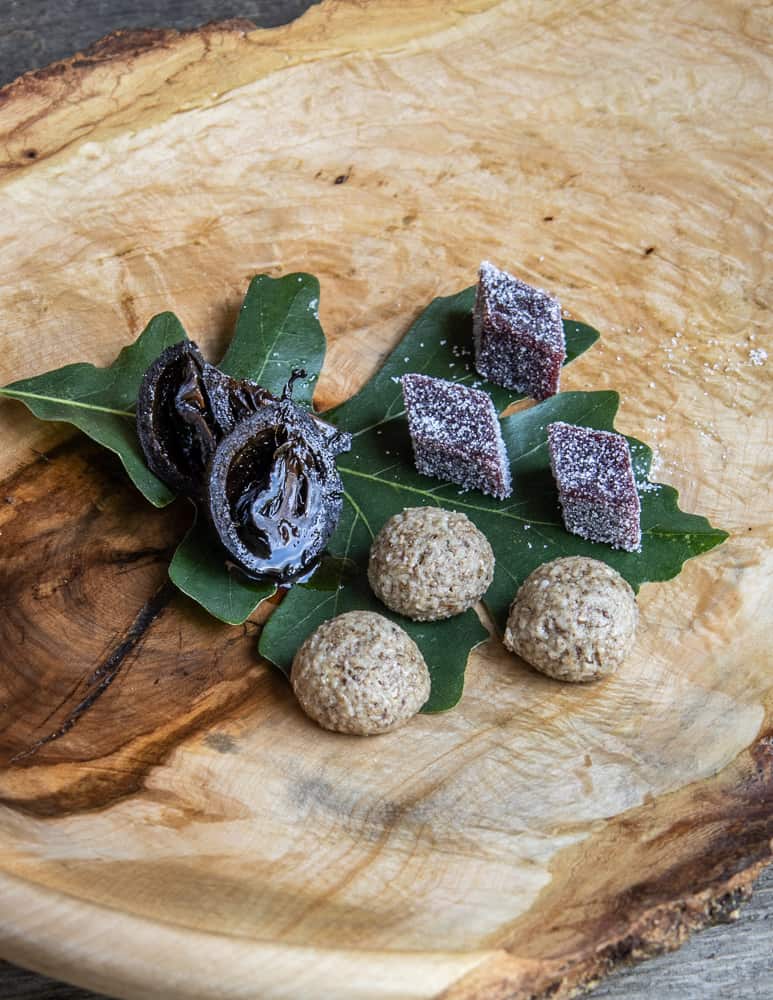
Related Posts
Lastly, it's easy to harvest a lot of these. If you have some extra, I'd encourage you to check out the following:
Green Black Walnut Jam / Preserves
Ingredients
- 1 ½ pounds 680 g (roughly 30–-35) green black walnuts, the size of ping-pong balls
- Handful of dried galium leaves or a vanilla bean (seeds removed), or a tablespoon of vanilla extract
- 4 cups 800 g sugar
- 4 cups 945 ml water
- ¼ cup 60 ml fresh lemon juice
- Handful of dried galium leaves a vanilla bean (seeds removed), or a teaspoon or two of vanilla extract
Instructions
Peeling
- Using a sturdy vegetable peeler and gloves to prevent staining your hands, peel the green walnuts, which will be more difficult than it sounds. Next, pierce the walnuts 5 or 6 times each with a thick needle, the tip of a thermometer, or any other small, sharp object-a fork can work too.
Soaking
- Put the peeled green nuts in a container, cover with water by an inch, and allow them to ferment for a week, burping occasionally and changing the water a few times, or as often as you can remember.
Finishing
- After a week, drain the walnuts and tie the galium in cheesecloth for easy removal if you’re using it.
- Combine with the sugar, and water, and galium or vanilla and simmer for roughly 1 hour on low heat.
- Skim off and discard any scum or foam that rises to the top, to ensure a clear syrup. Discard the galium leaves. If you used a vanilla bean, save it to pack in the jar(s).
- After an hour, turn up the heat, bring the syrup to a boil, and reduce until it looks like warm honey, and coats the back of a spoon, about 15 to -20 minutes, then turn off the heat and transfer the nuts to mason jars with tight-fitting lids (I like quart jars here) to cool.
- Add a tablespoon of lemon juice to each jar, fill nearly to the brim with the boiling hot syrup, screw on the lids and turn the jars upside down. You’ll probably have some syrup left over.
- There's no need to water-bath process these as the heavy syrup and additional acid make for a very strong preservative. After the jars cool, they should have sealed.
- The jars should seal naturally from the heat of the syrup, but any that don’t can be processed in a water bath. Allow the walnuts to age for at least a month before enjoying. Harvested at the right stage, I guarantee you they’re worth the wait.

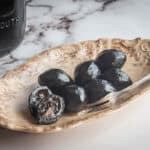
Emmanuelle
Hi Alan, I just finished cooking the nuts and putting it in jars, and I realize I forgot to add the lemon juice... do you think I should start over again?
Alan Bergo
Hey there. The sugar syrup is so concentrated that it will probably be fine, but you could run the risk of the jars crystalizing, and the flavor will be sub-par without the lemon. Personally I would empty the jars, bring them back to a boil and add the lemon, but if your question is more along the lines of safety, you're probably fine.
Rose Steele
I'm about to try this and I plan to water-bath can them for longer storage. I'm thinking I can get more in a jar if I cut them in half like you show for serving. Will that work? To be clear, I mean do everything as your recipe says through number 5, then split them, stuff them in the jars with the syrup and water bath can for 15 mins (I'm at sea level). What do you think? Thanks!
Alan Bergo
Hi Rose, I wouldn't cut them in half as the sugar could warp the edges and it isn't traditional. That said, you could try. Part of the appeal here is the perfect shape after they're peeled, and they are never sold pre-cut. I cut the nuts in halves or quarters (right before serving) so one jar (of whatever size) is ample for people to get a taste. I can get 40-60 portions from a quart jar like that, so fitting more in a jar, at least for me, is unnecessary.
Rose Steele
thank you! I will take your advice and do them the way you have written. I'll let you know. 🙂
Angie
Hello! Excited to come across yet another of your recipes. I have a question about peeling the nuts. I read several recipes before coming across yours, and none mention peeling. Cutting the ends off and piercing the skins, yes, but no mention of peeling and they say their recipes come out fine. Do you find peeling the outer layer to be a necessary step? I notice some let theirs soak upwards of 3 weeks... maybe that's a key point I'm missing? I'd love to hear your expertise regarding this. I can't wait to get started!
Alan Bergo
Hi Angie. Peeling is not optional for me and it greatly improves the texture IMO. I want as little husk as possible.
Sam Chak
Hi Alan, very intrigued by the entire process!
I’ve gathered more than a dozen green walnuts 3 days ago…but there’s hundreds higher up on branches I’d never be able to reach. They’re much larger than you’ve shown on your YT video, almost golf ball sized. I’ve peeled and pierced them with a metal skewer, but have encountered some resistance even though it’s gone right through. They’re now soaking in their bath for a week. Is it worth proceeding as written above, leaving it to soak for longer(do I refrigerate here please?) or anything else you suggest will be very much appreciated.
Also, “handful of dried galium leaves” appears twice on the recipe card, I'm hoping that I’ve not missed an instruction. Thank you kindly.
Alan Bergo
Hi Sam, if you met any resistance the nuts are not to be used for this.
John Paul
I just got done and ended up with 2 pint jars-worth. I was thinking of transferring to smaller jars too give as gifts. Can I just dump the syrup into a pot, re-boil, and then re-can as normal? Or would the lemon juice do anything undesirable during the boiling process? If so, should I instead use a water bath to re-can into smaller jars?
Alan Bergo
I would feel comfortable doing that. It’s a really heavy syrup so it’s very stable.
Tara
So by peeling you mean getting rid of all the green stuff?
Alan Bergo
I spent a lot of time on the video where I go over this. Please watch as it's easier to see than to describe. You're not peeling all of it off, just one pass with the peeler.
Heather Johnson
Hi Alan; I have been following your blog/website for quite a while and so appreciate receiving the notifications of your amazing creations via email!
I have soaked the walnuts I harvested (which look just like your picture so I think "I'm good" there!). I put the jar they were in inside of a ziploc bag (I misjudged the size of jar I needed and it wouldn't close) and then placed the filled jar in a ziploc bag.
I've soaked them for 10 days and they are jet black. They smell slightly fermented...not really an offensive smell and only had a very tiny spot of surface mold.
How does one know *if* the walnuts are bad before putting them in the pan to boil? I'd hate to waste all that sugar since I don't cook with it very often!
Thank you so much for sharing your amazing talent!
Alan Bergo
Hi Heather, they're not bad, the fermentation is just part of the process. It will probably seem strange to most people but the soaking is needed to remove some of the tannins in the walnuts, it also lowers their pH. If you change the water regularly you won't ever have mold. If you've soaked the peeled, pierced nuts for a week, rinse the nuts in a change or two of water until you don't notice any aroma, then proceed with the recipe.
With some traditional foods that may have parts of the method that are out of your comfort zone, remember that heating is a kill step. Boiling, especially for an extended period like this recipe involves, will make just about anything shelf stable and safe. Not only are the nuts fermented, but they're boiled in a heavy syrup finished with lemon juice. This is a very old preserve, and a safe one.
Heather Johnson
Thank you so much for the quick reply! Proceeding now and anxious to try this deliciousness.
Alan Bergo
You bet. Let me know how it works after you've aged the jar for a month.
Deks
Unfortunately boiling can not solve everything. If harmful mycotoxins are present in the walnuts, boiling will not destroy them.
casey
mine have been in water for a week but, still not even close to being darkly stained. keep fermenting?
Alan Bergo
Don’t worry cooking them will take care of that. They get crazy dark once they’re exposed to heat in the pot.
Lanni @greenerpostures
Loving the green walnut info. Thank you so much. Has anyone tried these recipes with green English walnuts? I don’t have access to a black walnut tree, but we have plenty of English.
Alan Bergo
English walnuts can be used to make this.
Neil Shaba
I saw another recipe which boiled the walnuts 5 time and discarded the boiling water after soaking to get rid of bitterness. Is this necessary please?
Alan Bergo
No. It isn’t necessary. If you read my recipe you’ll see the nuts are soaked for a week to leech them.
Kati
Hello! I've been dying to try making this recipe ever since my mother brought back a delicious jar of these from a trip to Greece. However, here in Northern Colorado all the walnut trees I know of have been wiped out by the thousand cankers fungus. There are a few pecan trees that aren't able to produce mature fruits do to our short growing season. Given that they are in the same family/both edible, do you think immature green pecans could be used instead of the walnuts in this recipe? I don't know if green pecans are indeed edible/not toxic. Thanks for sharing these fantastic recipes!
Alan Bergo
They wouldn't be toxic. I have done it, but it could work. People have used shagbark hickory.
Dasha
My grandmother made these when I was growing up and I'd been searching for the recipe. Thank you so much! These turned out even better than I remember.
Alan Bergo
Thanks Dasha. Glad they worked for you. You can buy them in jars too but the homemade ones are much better.
John Paul
Just made these for the first time. Waiting a month before I try one.
One thing that tripped me up was the instruction to "simmer for an hour or until the walnuts soften."
A. Is that a "whichever comes first" scenario? Or that you should simmer until the walnuts are soft (which is about an hour)?
B. What kind of softness should I be looking for? Soft like an orange, or soft like a gummy bear, or something else?
I boiled my syrup for too long until it started to re-crystalize, so I added more water and boiled again. The syrup came out a perfect consistency this time, but the walnuts are definitely not what I would describe as "soft" even after effectively boiling them for the double the time. Any insights would be great, thanks!
Also, just for an FYI, my walnuts were a little smaller than a ping pong ball so after peeling ~25 I only had about 8 oz. I pierced them and soaked them in water for about 1.5 weeks. When it came time to boil them, I only added 2 cups water and 2 cups sugar.
Alan Bergo
They'll never be "tender" soft is relative here. Someone else just commented today and they turned out fine. Making them is a learned skill and can take some practice. I would guess your heat was a little high. They're very forgiving though.
Juniper T
So excited to try this! I was too late in the season last year.
When it's time to eat these, do you eat the whole thing, shell husk and all? Pull the nut meat out? Get rid of the husk? Any and all consuming tips are appreciated
Alan Bergo
Eat the whole thing.
Emilee Elder
Hi Alan! I've learned so much about foraging from your book and blog! I'd like to try this recipe in the summer, but i was curious as to which species Galium leaves to use?
Alan Bergo
Hello. The galium is optional. You want to use G. triflorum, or sweet woodruff.
Michelle
Okay, so what happens if I only changed the water once and ended up fermenting them for close to two weeks?
Doug DeCarlo
I really like this. But I might like the syrup that results better than the preserved walnuts themselves, although that might be because I harvested a little too late (the timing was from a storm).
Favorite uses are to make "not coke" -- add a little lemon juice and mix with seltzer and what you get is somewhat like coke but a lot better. Also just glazed a ham using the syrup (in place of Dr Pepper in those ham glazing recipes) and it's fantastic.
Alan Bergo
Those are good ideas! But, if you prefer the syrup to the nuts themselves I'd wager that they were harvested too late. They're a favorite of mine for sharing with people.
Doug DeCarlo
This year I tried this with shagbark hickory nuts. I know of zero such trees with reachable nuts, but this year we had a very wet spring in NJ and then a 6-8 week dry spell - and a number of the hickory trees rejected about 50-75% of their nuts since they were set up for a mast year. No bugs - just shedding a load that couldn't be supported, I suppose. I only gathered the fresh looking ones that fell on a windy day. The nuts were a too old for this recipe (but still easy to cut), but I tried making just the syrup anyway with most of what I had. It's a lot faster of course - I just quartered them as with nocino, and cooked them as you describe here. No peeling and piercing. I strained it well before canning, so it's just syrup.
It's wonderful - like the syrup from a black walnut preparation, it makes great soda. And it's fantastic in place of the sugar in an Old Fashioned.
Vin de noix made with the rest of the nuts also came out good. It's helpful to know that "mistimed nuts" are still easily usable, at least for the syrup.
Alan Bergo
Hey Doug. Yes the flavor of the syrup is great. Perfect for things like root beer, sodas and drinks.
Becky
Hi there, I am wondering how long these will last in storage? I imagine pretty long but, I was just curious. Thank you for posting this. I have access to a ton of walnut trees so am excited to try this recipe next year. I think it may be too late this year.
Alan Bergo
You're too late now. The preserves last for years.
Z
I guess I simmered too long and the syrup became solid quickly after pouring. Any ideas to salvage, or do I just have to start over next season?
Alan Bergo
Add some water and warm the jars long enough to loosen it. Add it all back to a pot and bring back to a simmer to melt the sugar.
Max
I can’t decide whether to make this or the molasses. Which do you prefer/would you say is more unique (in terms of the flavor).
Alan Bergo
Make this first.
Baker
Hi, Alan! Thanks for this detailed info and recipe! If I were to save the walnuts themselves to eat later, you mentioned to age the walnuts for a month before using—what’s the best process to do that? Store them in the preserves? Just keep them in a sealed jar or container in the fridge? I’m experimenting with green walnuts from the farmer’s market for a cocktail and would love to use both the syrup in the drink and the walnut as the garnish. Thanks so much!
Alan Bergo
I think you're misunderstanding what's going on with this recipe. The walnuts are preserved in the syrup.
Allison
Ok if I pee them before soaking? And how much peel should be removed? My peel "chops' were about the thickness of an apple peel.
And big congrats on the James Beard award!
Brian
Alan, thanks for the recipe and the tip for peeling. I have seen recipes for walnut jam that use calcium hydroxide aka slaked lime aka cal mixed into water to make a solution that will help firm up the nuts. What are your thoughts on using it? Also, can this be done with both English and black walnuts?
Alan Chomica
Every year we forage from three Black Walnut trees and one English Walnut in the neighborhood. I usually just crack them and use them as nuts but this is definitely high on my list of ways to go forward. I wish I could locate the Galium but have not found a patch yet to collect any from.
I have a question about the water the nuts are soaked in. In my kitchen I can use tap water, high pH water from a filter, RO water and also distilled. you suggest the type of water that might be best to soak the nuts in?
Our season here on Vancouver Island is 30 to 60 days behind the calendar this year and the nuts I have been checking out are not quite to the point where you show they are ready. They will be soon though and this is my next big project in the kitchen.
Any suggestions on what to do with a major crop of hazelnuts? This year our seven big trees are just loaded and I have controlled the alien Grey Squirrels to the point the nuts will not be stolen by the pesky varmints...